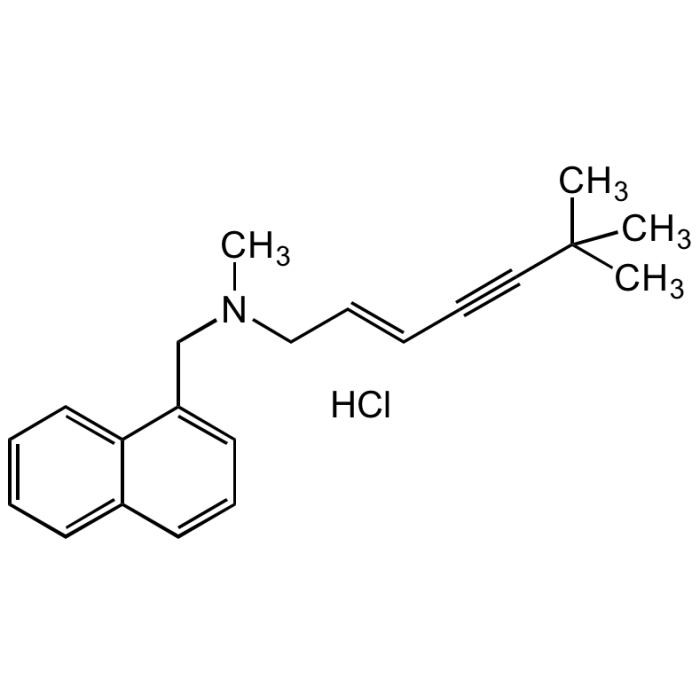Cookie Policy: This site uses cookies to improve your experience. You can find out more about our use of cookies in our Privacy Policy. By continuing to browse this site you agree to our use of cookies.
Chemodex
Terbinafine hydrochloride

| Product Details | |
|---|---|
| Synonyms | trans-N-(6,6-Dimethyl-2-hepten-4-ylyl)-N-methyl-1-naphthylmethylamine hydrochloride; N-[(2E)-6,6-dimethyl-2-hepten-4-yn-1-yl]-N-methyl-1-naphthalenemethanamine hydrochloride |
| Product Type | Chemical |
| Properties | |
| Formula | C21H25N . HCl |
| MW | 291.4 . 36.5 |
| CAS | 78628-80-5 |
| RTECS | QJ8600100 |
| Source/Host Chemicals | Synthetic |
| Purity Chemicals | ≥98% (HPLC) |
| Appearance | White to off-white powder. |
| Solubility | Soluble in ethanol (30mg/ml), DMSO (10mg/ml), DMF (10mg/ml), methanol (50 mg/ml). Sparingly soluble in acetone or water. |
| Identity | Determined by 1H-NMR. |
| Declaration | Manufactured by Chemodex. |
| Other Product Data |
Click here for Original Manufacturer Product Datasheet |
| InChi Key | BWMISRWJRUSYEX-SZKNIZGXSA-N |
| Smiles | CN(C/C=C/C#CC(C)(C)C)CC1=CC=CC2=CC=CC=C21.Cl |
| Shipping and Handling | |
| Shipping | AMBIENT |
| Short Term Storage | +4°C |
| Long Term Storage | -20°C |
| Use/Stability | Stable for at least 2 years after receipt when stored at -20°C. |
| Documents | |
| Product Specification Sheet | |
| Datasheet |
 Download PDF Download PDF |
Terbinafine is an antifungal and antimycotic compound that is highly active against dermatophytes, mold, other basic fungi, and some strains of yeast. It is clinically used to treat nail and skin infections. Inhibits ergosterol synthesis, essential component of fungal cell membranes. Potent non-competitive inhibitor at the stage of squalene epoxidation (IC50=30nM for C. albicans). Selective activator of the K2P channel TASK3 (pEC50 = 6.2). Exhibits >10-fold selectivity for TASK3 over TREK2, TRESK, THIK1 and TASK2. Also inhibits TWIK1 (pIC50 = 5.69). K2P channels might also be a target for ist antifungal activity. Shown to exhibit at higher concentrations anti-tumor and anti-angiogenic activity by inducing cell cycle arrest, and to display interesting anti-inflammatory and free radical scavenging activities.
(1) G. Petranyi, et al.; Science 224, 1239 (1984) | (2) N.S. Ryder & M.C. Dupont; Biochem. J. 230, 765 (1985) | (3) G. Petranyi, et al.; Antimicrob. Agents Chemother. 31, 1365 (1987) | (4) N. S. Ryder, et al.; Br. J. Dermatol. 126, 39 (1992) | (5) T. Rosen, et al.; Int. J. Dermatol. 36, 788 (1997) | (6) B. Favre, et al.; Arch. Biochem. Biophys. 340, 265 (1997) | (7) C.S. Sander, et al.; Mycoses 45, 152 (2002) | (8) W.S. Lee, et al.; Int. J. Canc. 106, 125 (2003) | (9) P.Y. Ho, et al.; J. Canc. 111, 51 (2004) | (10) P.D. Wright, et al.; BBRC 493, 444 (2017)





